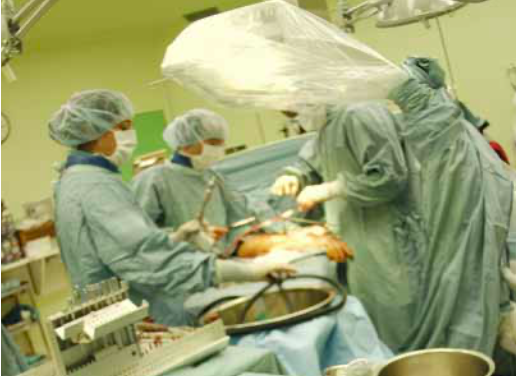Abstract
Background: The concept of a fast track (Enhanced Recovery After Surgery, ERAS) was introduced to colorectal surgery in Denmark by Kehlet in 1999 which improved the quality of the care and reduced the length of hospital stay following major colorectal surgery. The same principles of ERAS have been applied to the orthopaedic surgery particularly the hip and knee replacement surgery and fracture neck of femur surgery. It is a relatively new approach in orthopaedics to the preoperative, intraoperative and postoperative care of the patients undergoing surgery.
Methods: We have compared the length of inpatient stay, day of mobilisation, postoperative blood transfusion and adverse outcome for the patients undergoing hip or knee replacement by a single surgeon (KS) between ERAS and NON ERAS patients.
Results: A total of 138 patients underwent hip or knee replacement, hip resurfacing arthroplasty or oxford unicompartmental arthroplasty between July 2011 and June 2012 with ERAS protocol. In the Non-ERAS group, 140 patients underwent hip or knee arthroplasty, resurfacing or oxford uni-compartmental knee replacement in the previous year (July 2010 to June 2011) by the same surgeon.
Average hospital inpatient stays for the ERAS patients was 4.12 days with 73.10% of the patients having an inpatient hospital stay of less than or equal to 5 days. The average hospital inpatient stays for the NON-ERAS patients was 8.34 days with only 24.08% of the patients being discharged in less than or equal to 5 days.
Conclusions: Our study shows that the implementation of the ERAS protocol in hip and knee replacement surgery is associated with improved patient experience, faster recovery and shorter hospital inpatient stay with no increase in complication.
References
Kehlet, H and Morgensen T. 1999, ‘Hospital stay of 2 days after open sigmoidectomy with a multimodal rehabilitation programme British Journal of Surgery, Feb; 86 (2):227-30.
Modernising Care for Patients undergoing Major Surgery: www. reducinglengthofstay.org.
1000 Lives Plus: www.1000lives.wales.nhs.uk
Urbach, DR and Baxter, NN. 2005. Reducing variation in surgical care. BMJ 2005; 330 :1401 doi: 10.1136/bmj.330.7505.1401 (Published 16 June 2005)
Delivering Enhanced Recovery after Surgery: Helping patients recover better after surgery. http://tinyurl.com/y2qeplm (Accessed 26th June 2010)
Enhanced recovery after surgery programs hastens recovery after colorectal resections. Ned Abraham, Sinan Albayati. world journal of Gastrointestinal Surgery 2011 January 27; 3(1):1-6, (editorial)
National joint registry for England and wales : 7th annual report. 2010
Scott Beattie w, et al (2009), ‘Risk Associated with Preoperative Anaemia in Noncardiac Surgery’, Anaesthesiology; 110:574 – 81
AAGBI Safety Guideline (2010), ‘Pre-operative assessment and patient preparation, the role of the anaesthetist’, The Association of Anaesthetists of Great Britain and Ireland
Oxford textbook of orthopaedics and trauma 2002
http://hospital.blood.co.uk/library/pdf/INF_PCS_HL_011_01_Iron_ leaflet.pdf
www.transfusionguidelines.org.uk
www.nhs.uk/Conditions/Anaemia-iron-deficiency/Pages/ MapofMedicinepage.aspx
UK Prospective Diabetes Study, Diabetes Control and Complications Trial
www.lho.org.uk/viewResource.aspx?id=9776
Shourie S. et al (2007), ‘Pre-operative screening for excessive alcohol consumption among patients scheduled for elective surgery’, Drug and Alcohol Review, 26: 119–125
Dix P and Howell S (2001), ‘Survey of cancellation rate of hypertensive patients undergoing anaesthesia and elective surgery, British’. Journal of Anaesthesia, 86 (6):789-793
Goldman L and Caldera DL (1979), ‘Risks of general anaesthesia and elective surgery in the hypertensive patient’, Anaesthesiology; 50: 285–92
Ramsay LE, Williams B, Johnston GD, et al (1999), ‘British Hypertension Society guidelines for hypertension management’, summary. BMJ; 319: 630–5
‘The Health Promotion Action plan for Older People in wales’ (2004), Health Challenge wales, welsh Government
Welsh Risk Pool (2005), ‘welsh risk management standards 2004-2005’, St. Asaph:
Local infiltration analgesia: a technique for the control of acute postoperative pain following knee and hip surgery. A case study of 325 patients. Dennis R Kerr, Lawrence Kohan: Acta orthopaedic 2008; 79 (2): 174-183
Efficacy of periarticular multimodal drug injection in total knee arthroplasty. A Randomised trial: Constant A. Busch, Benjamin J. Shore, Rakesh Bhandari, Su Ganapathi, Steven J. MacDonald, Robert B. Bourne, Cecil H. Rorabeck and Richard w. McCalden.: JBJS Am. 88:959-963,2006. Doi:10.2106/JBJS.E.00344
Pain control after total knee arthroplasty: A Prospective study comparing local infiltration anaesthesia and epidural anaesthesia: Martin Thorsell, MD; Petter Hoist, MD: Hans Christian Hyldahl, MD: Lars Weidenhielm, MD: Orthopaedics 33 w, 75-80 (Feb 2010)
Anti-Fibrinolytic use for minimising perioperative allogenic blood transfusion (review) 2007: Henry DA, Carsen PA et al: Cochrane collaboration
Magnesium as an adjuvant to postoperative analgesia: A systematic review of randomised trials: Christopher Lysakowski, MD: Anesth Analg 2007: 104: 1532-9
Gabapentin and postoperative pain: a qualitative and quantitative systematic review, with focus on procedure: Ole Mathiesen, Steen Moiniche and Jorgen B Dahl: BMC Anesthesiology 2007, 7:6
Pregabalin and Dexamethasone improves post-operative pain treatment after tonsillectomy: O Mathiesen, D G Jorgensen et al: Acta Anaesthesiol Scand 2011; 55:297-305
Single dose Dexamethasone reduces dynamic pain after total hip arthroplasty: Anaesth Analg: 2008: 106:1253-7
Multimodal analgesia with Gabapentin, ketamine and Dexamethasone in combination with paracetamol and ketorolac after hip arthroplasty : a preliminary study: Michael L. Rasmussen, Ole Mathiesen, Gerd Dierking et al: Eur J Anaeshtesiol 2010;27: 324-330
Low risk of thromboembolic complications after fast tract hip and knee arthroplasty. : Henrik Husted, Kristian Stahl Otte et al: Acta Orthopaedica 2010; 81 (5): 599-605

This work is licensed under a Creative Commons Attribution-NonCommercial-NoDerivatives 4.0 International License.
Copyright (c) 2012 Array

